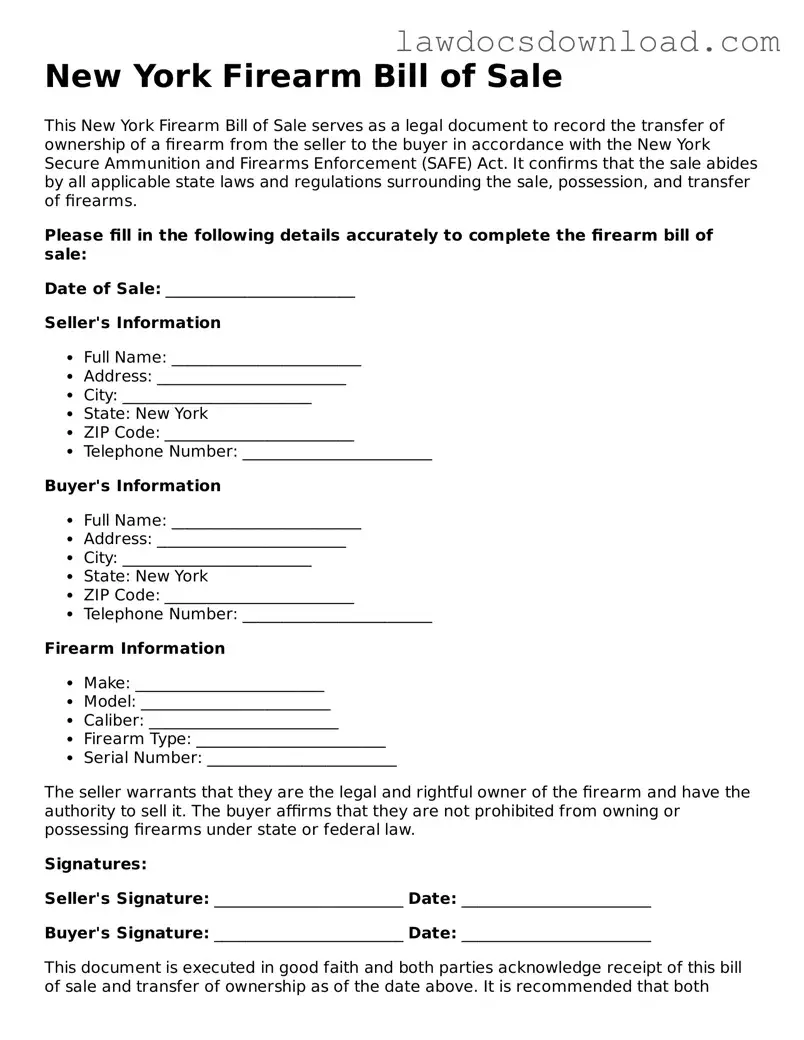The New York Firearm Bill of Sale is akin to the Vehicle Bill of Sale, which serves as a documented agreement between a seller and a buyer for the purchase of a vehicle. Just like the Firearm Bill of Sale, this document provides proof of transfer of ownership and details about the item sold, including model, make, year, and VIN for vehicles, ensuring a transparent transaction and aiding in the legal registration process.
Another document similar to the New York Firearm Bill of Sale is the General Bill of Sale. This form is used for buying or selling personal property across various categories. Both documents act as receipts for transactions and include essential information like the date of sale, identification of the buyer and seller, and specifics about the item sold, offering legal protection and serving as a record of the sale.
The Boat Bill of Sale closely aligns with the Firearm Bill of Sale by providing evidence of the transfer of ownership for a boat from the seller to the buyer. Specific details such as the boat’s make, model, year, and hull identification number are included, mirroring the detailed description required in firearm sales to ensure both parties are clear about the transaction's parameters.
Similar to the New York Firearm Bill of Sale, the Equipment Bill of Sale is used for the sale and purchase of physical items, specifically equipment. The document solidifies the transaction by detailing the equipment's condition, serial number, and purchase price, which parallels the thorough itemization seen in firearm sales documentation to legitimize the deal and clarify ownership.
The Artwork Bill of Sale shares similarities with the Firearm Bill of Sale in providing a record of the sale of a piece of art. Both documents include detailed descriptions of the item sold, the names and addresses of the buyer and seller, and the sale date. These details are crucial for cataloging purposes and confirming the authenticity and ownership of high-value items.
Comparable to the Firearm Bill of Sale, the Pet Bill of Sale documents the sale and transfer of ownership of pets. It details the animal's breed, age, health information, and any relevant registration numbers, akin to the firearm sale's specificity about the item changing hands. This contract ensures transparency and aids in legal compliance for the sale of pets, similarly to firearms.
The Business Bill of Sale is analogous to the Firearm Bill of Sale as it documents the transfer of ownership of a business or business assets. This document contains detailed information about the business being sold, including assets, inventory, and operational information, closely reflecting the detailed nature of firearm sales documentation, aimed at ensuring a clear and legal transfer of property.
The Real Estate Bill of Sale is another document similar to the Firearm Bill of Sale, used during the sale of real property. While significantly different in the type of property being transferred, both documents serve to legally document the details of the transaction, including the parties involved, the date of sale, and specific details about the property sold, ensuring a clear understanding and agreement between buyer and seller.
Lastly, the Antiques Bill of Sale can be compared to the Firearm Bill of Sale as it is utilized for transactions involving antique items. Both documents ensure that the details of the items sold are meticulously recorded, including the item's age, condition, and any other aspects that contribute to its value. They serve to authenticate the transaction, providing a historical record that can be important for future valuation or sales.
